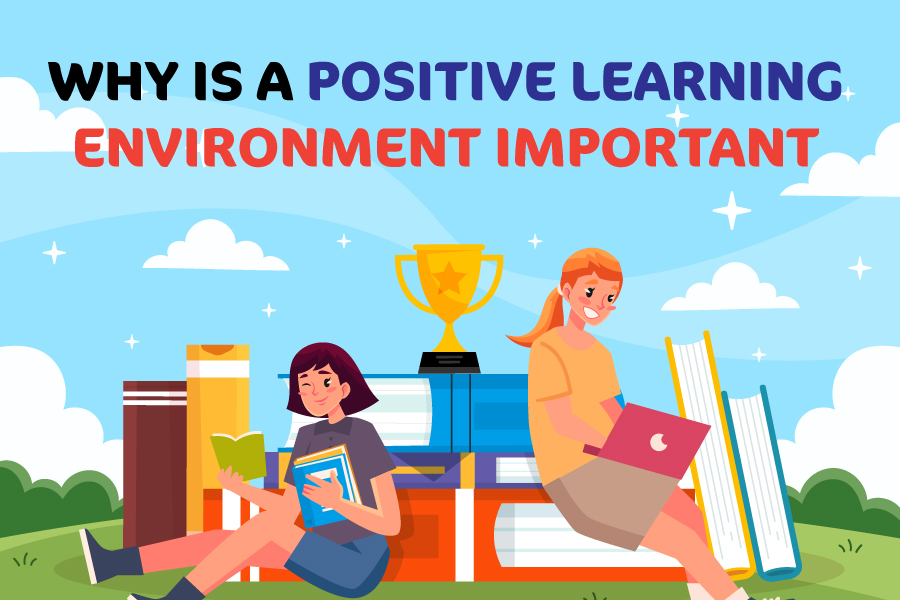In the ever-evolving landscape of education, the significance of fostering a positive learning environment cannot be overstated. As educators, we understand that the learning process extends far beyond the mere transmission of knowledge. It encompasses the creation of an atmosphere that nurtures intellectual curiosity, emotional well-being, and personal growth. A positive learning environment is the bedrock upon which academic success and personal development are built, empowering students to reach their full potential.
The Impact Of A Positive Learning Environment On Student Success
A positive learning environment has a profound impact on student success, both academically and personally. When students feel safe, supported, and respected, they are more likely to engage in the learning process, take risks, and explore new ideas without fear of judgment or failure. This sense of security and encouragement fosters a growth mindset, which is essential for overcoming challenges and embracing lifelong learning.
Moreover, a positive learning environment promotes better retention of information, as students are more receptive to the material when they feel comfortable and motivated. It also enhances critical thinking and problem-solving skills, as students are encouraged to ask questions, express their opinions, and collaborate with their peers in a supportive environment.
Characteristics Of A Positive Learning Environment
A positive learning environment is characterized by several key elements:
Respect and Inclusivity: An atmosphere of mutual respect, where all students feel valued, accepted, and included, regardless of their backgrounds or abilities.
Emotional Safety: A safe space where students can express their thoughts, feelings, and ideas without fear of ridicule or judgment.
Encouragement and Support: A nurturing environment that celebrates effort, recognizes progress, and provides constructive feedback to help students grow and improve.
Collaboration and Teamwork: An environment that fosters collaboration, teamwork, and peer support, allowing students to learn from one another and develop essential social skills.
Engaging and Stimulating: A dynamic and stimulating atmosphere that sparks curiosity, promotes creativity, and encourages active participation in the learning process.
Creating A Physically Supportive Learning Environment
The physical environment plays a crucial role in shaping a positive learning atmosphere. A well-designed classroom can promote engagement, collaboration, and a sense of belonging. Here are some strategies for creating a physically supportive learning environment:
- Flexible Seating Arrangements: Incorporate a variety of seating options, such as desks, tables, and comfortable seating areas, to accommodate different learning styles and activities. Invest in a teak study table that provides durability and a natural aesthetic to enhance the classroom environment. Such sturdy furniture helps create a stable and supportive physical space for student learning.
- Optimal Lighting and Temperature: Ensure that the classroom has adequate lighting and a comfortable temperature to promote focus and prevent distractions.
- Organized and Clutter-Free: Maintain an organized and clutter-free space, as a cluttered environment can be visually distracting and overwhelming for students.
- Accessibility: Design the classroom to be accessible and inclusive for students with diverse needs, ensuring that all students can participate fully in the learning process.
- Personalized Touches: Incorporate personal touches, such as student artwork, motivational quotes, or cultural representations, to create a sense of ownership and belonging.
Cultivating A Psychologically Safe Learning Environment
While the physical environment is important, creating a psychologically safe learning environment is equally crucial. A psychologically safe environment fosters a sense of trust, respect, and emotional security, allowing students to take risks, express themselves freely, and engage in meaningful learning experiences. Here are some strategies for cultivating a psychologically safe learning environment:
- Establish Clear Expectations and Boundaries: Clearly communicate expectations, rules, and boundaries to create a sense of structure and predictability, which can help students feel secure and focused.
- Promote Open Communication: Encourage open and respectful communication, where students feel comfortable sharing their thoughts, asking questions, and expressing concerns without fear of judgment or repercussions.
- Embrace Diversity and Inclusivity: Celebrate diversity and create an inclusive environment where all students feel valued, respected, and represented, regardless of their backgrounds or identities.
- Foster a Growth Mindset: Promote a growth mindset by emphasizing effort, perseverance, and learning from mistakes, rather than solely focusing on achievement or perfection.
- Provide Emotional Support: Be attuned to the emotional needs of your students and provide appropriate support, whether through one-on-one conversations, counseling services, or referrals to additional resources.
The Role Of Positive Teacher-Student Relationships In Creating A Positive Learning Environment
Positive teacher-student relationships are the cornerstone of a positive learning environment. When students feel a genuine connection with their teachers, they are more likely to feel motivated, engaged, and invested in the learning process. Here are some strategies for building positive teacher-student relationships:
Show Genuine Care and Concern: Demonstrate genuine care and concern for your students’ well-being, both academically and personally, by actively listening, offering support, and showing empathy.
Provide Individualized Attention: Make an effort to get to know your students on an individual level, understanding their strengths, weaknesses, interests, and learning styles, and tailoring your approach accordingly.
Celebrate Achievements and Milestones: Recognize and celebrate your students’ achievements and milestones, no matter how small, to foster a sense of accomplishment and motivation.
Encourage Open Communication: Establish an open and respectful communication channel, where students feel comfortable sharing their thoughts, concerns, and feedback without fear of judgment or repercussions.
Lead by Example: Model the behavior and attitudes you wish to cultivate in your students, such as respect, kindness, perseverance, and a love for learning.
Strategies For Promoting A Positive Learning Environment
Creating a positive learning environment is an ongoing process that requires intentional effort and commitment. Here are some effective strategies for promoting a positive learning environment:
- Establish a Classroom Community: Foster a sense of community in your classroom by encouraging collaboration, teamwork, and peer support. Facilitate activities that promote social-emotional learning and build strong relationships among students.
- Incorporate Student Voices and Choice: Involve students in decision-making processes, such as choosing classroom rules, setting goals, or selecting learning activities, to promote a sense of ownership and autonomy.
- Embrace Diverse Learning Styles: Recognize that students have different learning styles and preferences, and incorporate a variety of teaching methods, resources, and activities to engage all learners.
- Provide Constructive Feedback: Offer constructive feedback that focuses on growth and improvement, rather than criticism or judgment. Celebrate effort and progress, and provide specific guidance for areas of improvement.
- Promote Mindfulness and Self-Care: Encourage students to practice mindfulness and self-care strategies to manage stress, anxiety, and emotional well-being, which can positively impact their ability to learn and thrive.
The Benefits Of A Positive Learning Environment For Students With Diverse Needs
A positive learning environment is particularly beneficial for students with diverse needs, such as those with disabilities, learning differences, or cultural and linguistic backgrounds. By creating an inclusive and supportive atmosphere, these students can feel valued, understood, and empowered to reach their full potential. Here are some specific benefits of a positive learning environment for students with diverse needs:
- Increased Engagement and Motivation: When students feel accepted and supported, they are more likely to engage actively in the learning process, participate in class discussions, and take risks without fear of judgment or failure.
- Enhanced Self-Confidence and Self-Esteem: A positive learning environment fosters a sense of belonging and acceptance, which can boost self-confidence and self-esteem, enabling students to embrace their unique strengths and overcome challenges.
- Improved Academic Performance: By providing appropriate accommodations, differentiated instruction, and a supportive environment, students with diverse needs can better access the curriculum and achieve academic success.
- Development of Social-Emotional Skills: A positive learning environment promotes the development of essential social-emotional skills, such as empathy, resilience, and effective communication, which are crucial for personal and academic growth.
- Increased Sense of Belonging: When students feel valued and represented in the learning environment, they develop a stronger sense of belonging, which can positively impact their overall well-being and academic achievement.
The Role Of Parents And Caregivers In Fostering A Positive Learning Environment
While educators play a pivotal role in creating a positive learning environment within the classroom, the involvement of parents and caregivers is equally important. A collaborative partnership between educators and families can significantly enhance the learning experience and foster a positive atmosphere both at school and at home. Here are some ways parents and caregivers can contribute to fostering a positive learning environment:
Maintain Open Communication: Engage in regular communication with teachers and school staff to stay informed about your child’s progress, challenges, and the learning environment. Share relevant information about your child’s interests, strengths, and needs to support their learning journey.
Reinforce Positive Attitudes and Behaviors: Model and reinforce positive attitudes towards learning, respect for educators, and a growth mindset at home. Celebrate your child’s efforts, progress, and achievements, and encourage them to embrace challenges as opportunities for growth.
Create a Supportive Home Environment: Establish a dedicated study space and routine at home that promotes focus and minimizes distractions. Provide access to educational resources, such as books, educational websites, and learning materials, to support your child’s academic journey.
Encourage Extracurricular Activities: Encourage your child to participate in extracurricular activities that align with their interests and passions, as these activities can foster social-emotional development, build confidence, and create a well-rounded learning experience.
Advocate for Your Child’s Needs: If your child has specific learning needs or requires accommodations, work closely with the school to ensure that appropriate support and resources are provided to create an inclusive and supportive learning environment.
Conclusion
In the ever-evolving landscape of education, creating a positive learning environment is paramount to fostering academic success, personal growth, and overall well-being for students. By cultivating an atmosphere of respect, inclusivity, emotional safety, and support, we empower students to embrace challenges, explore new ideas, and reach their full potential. As educators, we have the opportunity to shape the learning experiences of our students, not just through the curriculum we teach but also through the environment we create. By implementing strategies that promote a positive learning atmosphere, we can ignite a passion for learning, build resilience, and equip our students with the skills and mindset necessary to thrive in an ever-changing world.
Remember, a positive learning environment is not just a nice-to-have; it is a fundamental component of effective education. By prioritizing this aspect, we can unlock the true potential of our students and ensure that they not only acquire knowledge but also develop the confidence, creativity, and social-emotional skills necessary for lifelong success.












































Leave a Reply